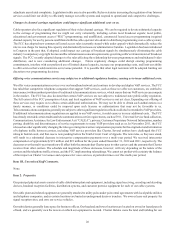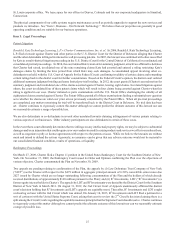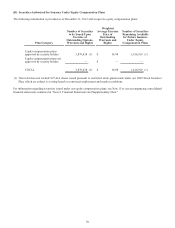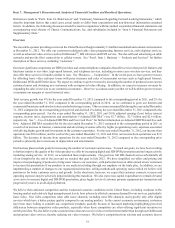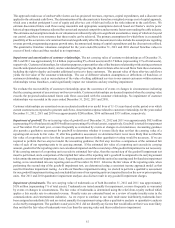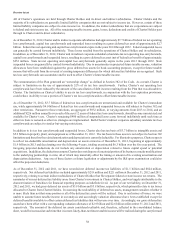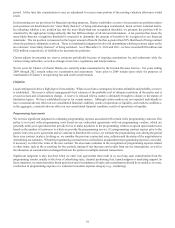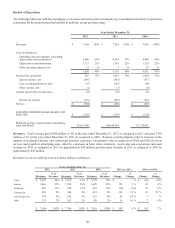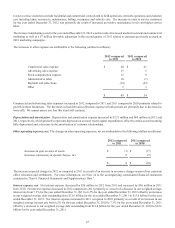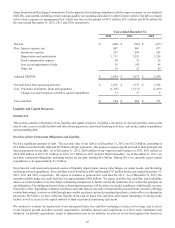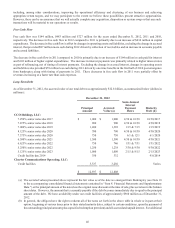Charter 2012 Annual Report Download - page 48
Download and view the complete annual report
Please find page 48 of the 2012 Charter annual report below. You can navigate through the pages in the report by either clicking on the pages listed below, or by using the keyword search tool below to find specific information within the annual report.36
weighted average remaining useful life of our property, plant and equipment as of December 31, 2012 would be a decrease in
annual depreciation expense of approximately $193 million.
Depreciation expense related to property, plant and equipment totaled $1.4 billion, $1.3 billion and $1.2 billion for the years ended
December 31, 2012, 2011 and 2010, respectively, representing approximately 21%, 21% and 20% of costs and expenses,
respectively. Depreciation is recorded using the straight-line composite method over management’s estimate of the useful lives
of the related assets as listed below:
Cable distribution systems……………………………… 7-20 years
Customer equipment and installations………………….. 4-8 years
Vehicles and equipment………………………………… 1-6 years
Buildings and leasehold improvements………………… 15-40 years
Furniture, fixtures and equipment….…………………… 6-10 years
Intangible assets
Impairment of franchises. The net carrying value of franchises as of both December 31, 2012 and 2011 was approximately $5.3
billion (representing 34% of total assets). Franchise rights represent the value attributed to agreements or authorizations with
local and state authorities that allow access to homes in cable service areas. For valuation purposes, they are defined as the future
economic benefits of the right to solicit and service potential customers (customer marketing rights), and the right to deploy and
market new services, such as Internet and telephone, to potential customers (service marketing rights).
Franchise intangible assets that meet specified indefinite life criteria must be tested for impairment annually, or more frequently
as warranted by events or changes in circumstances. In determining whether our franchises have an indefinite life, we considered
the likelihood of franchise renewals, the expected costs of franchise renewals, and the technological state of the associated cable
systems, with a view to whether or not we are in compliance with any technology upgrading requirements specified in a franchise
agreement. We have concluded that as of December 31, 2012 and 2011 all of our franchises qualify for indefinite life treatment.
Franchises are aggregated into essentially inseparable units of accounting to conduct valuations. The units of accounting have
historically represented geographical clustering of our cable systems into groups by which such systems were managed. In 2012,
as a result of changes to our organizational structure, the evolution of competition in the industry, and changes in the regulatory
environment, we concluded that the highest and best use of our franchise assets is at the consolidated level and as such combined
our units of accounting into one unit as of November 30, 2012. As required by the accounting guidance on testing indefinite-lived
intangible assets for impairment, we tested our franchise assets first based on the prior units of accounting before testing the new
unit of accounting. No impairment was identified based on the new or prior units of accounting.
During 2012, we early adopted Accounting Standards Update ("ASU") No. 2012-02, Testing Indefinite Lived Intangible Assets
for Impairment. This new standard gives us the option to first assess qualitative factors to determine whether the existence of
events or circumstances leads to a determination that it is more likely than not that an indefinite lived intangible asset has been
impaired. If, after this qualitative assessment, we determine that it is not more likely than not that an indefinite lived intangible
asset has been impaired, then no further quantitative testing is necessary. In completing our 2012 impairment testing of both the
prior units of accounting and the new unit of accounting, we elected to perform this qualitative assessment. As such, we evaluated
the impact of various factors to the expected future cash flows attributable to each of our units of accounting and to the assumed
discount rate used to present value those cash flows. Such factors included macro-economic and industry conditions including the
capital markets, regulatory, and competitive environment, and costs of programming and customer premise equipment along with
changes to our organizational structure and strategies. After consideration of these qualitative factors, we concluded that it is
more likely than not that the fair value of the franchise assets in each unit of accounting exceeds the carrying value of such assets
and therefore did not perform a quantitative analysis in 2012.
If we are required to perform a quantitative analysis to test our franchise assets for impairment, we determine the estimated fair
value of each unit of accounting utilizing an income approach model based on the present value of the estimated discrete future
cash flows attributable to each of the intangible assets identified for each unit assuming a discount rate. The fair value of franchises
for impairment testing is determined based on estimated discrete discounted future cash flows using assumptions consistent with
internal forecasts. The franchise after-tax cash flow is calculated as the after-tax cash flow generated by the potential customers
obtained (less the anticipated customer churn), and the new services added to those customers in future periods. The sum of the
present value of the franchises' after-tax cash flow in years 1 through 10 and the continuing value of the after-tax cash flow beyond
year 10 yields the fair value of the franchises.


